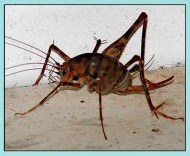Kill Cave Crickets Outdoors
How to Kill Cave Crickets and Eggs Under Porches, Decks, Foundations and Mulch Beds
Wipe Out Camel Crickets in the Yard and Destroy the Mold They Feed Upon
Cave crickets resemble giant spiders with thick, jointed hind legs for jumping. Most folks who encounter them indoors want to believe that a few  random invaders are normal at certain times of the year. The grim truth is that cave cricket sightings indicate much larger problems. The presence of cave crickets indoors is a clear sign of excessive cave cricket activity on the property. Those “random” invaders are members of an established community that will multiply year after year. If there’s enough mold in basements, crawlspaces or sub-floors to sustain occasional invaders, they can multiply quite comfortably indoors.
random invaders are normal at certain times of the year. The grim truth is that cave cricket sightings indicate much larger problems. The presence of cave crickets indoors is a clear sign of excessive cave cricket activity on the property. Those “random” invaders are members of an established community that will multiply year after year. If there’s enough mold in basements, crawlspaces or sub-floors to sustain occasional invaders, they can multiply quite comfortably indoors.
If you’re waiting for these intimidating pests to die off when winter hits, don’t hold your breath. Cave crickets pass the winter as nymphs and lay eggs in the spring soil. Adults can live up two years. Yard treatment is not just an optional measure of protection. It’s your first line of defense.
On especially hot days, cave crickets seek cool places to hang out, and they are attracted to cracks and crevices around the foundation of your home. They can come in through basement windows, floor vents and channels along pipelines. If you treat problem areas indoors without treating outside, you may see a reduction in numbers this year, but you’ll likely deal with a fresh burst of activity every summer, especially if the property was old or poorly maintained before you moved in.
Cedar oil is a powerful organic fungicide and microbicide that kills mold and mildew without harming grass or landscaping. It also kills cave crickets and their eggs. By treating flower beds and mulch beds that touch the perimeter of your home, you will not only kill adults and eggs, you will kill the mold they feed upon. Mulch beds are particularly inviting for insects that feed upon mold. Landscaping materials trap water close to the ground and block out sunlight, creating an optimal environment for mold to flourish.
A side benefit of treating grassy areas is the reduction of flea and tick populations. Cedar oils kills fleas, ticks, mites, and their eggs. That’s good news for pet owners who wish to avoid dangerous spot drop chemical treatments that cause more than 44,000 severe reactions a year, including seizures and death. Best of all, the intense cedar aroma builds a protective barrier that discourages new insects from entering sprayed territory. That includes mosquitoes, flies, cockroaches and a wide range of crop pests.
We often receive unsolicited testimonials from pest control operators around the country. Click Here to see what a parks and recreation employee in West Palm Beach has to say about this formula.
Instructions for Treating Indoors and Outdoors
—Use our OUTDOOR concentrate to treat the perimeter of your home, paying close attention to areas where shrubs and plants touch your home. (One gallon of concentrate makes 32 gallons of solution.) A good treatment early in the spring can kill nymphs and prevent future infestation. Feel free to mix the concentrate double strength the first time you apply it. Soak lawns, soils and mulch beds generously with a hose end sprayer.
—Use our INDOOR formula to treat under porches, decks, trailers and other elevated structures. Treat the perimeter of your basement, paying close attention to the seams where walls and ceilings meet. Spray basement window frames and seal any cracks you encounter. (Be advised that the indoor product is not formulated for gardens. It may kill grass and plants. Use our OUTDOOR formula for plants, shrubs and grassy areas that touch the home.)
Additional Tips and Tricks:
—Install a professional dryer vent seal. A variety of insects enter homes through cracks around dryer vent tubes. (Quality vent seals are sold at bestenergysavingproducts.com. Wholesale Pesticides is not affiliated with this company. We just like their product.)
—Pay close attention to drafts. Random gusts of wind are instrumental in leading us to cracks where bugs can enter the home. If there’s a closet or crawlspace that feels colder than the rest of the house, it’s a sure sign of a large crack that should be sealed immediately.
—Spray rugs and baseboards in bathrooms with our INDOOR formula. Don’t forget to treat under the sink where moist conditions create an optimal environment for the growth of mold. Our indoor formula won’t stain carpet.
—Treat fabrics and boxes in closets and crawlspaces to prevent cave crickets from destroying clothing. The indoor formula is formulated not to stain fabrics.
—Spray your yard with our OUTDOOR formula to create a natural barrier that discourages crickets and other insects from entering sprayed territory. The outdoor formula won’t harm plants.
—Don’t let leaves pile up beside your home. Cave crickets like to congregate in stacks of debris.
—Keep grass tightly trimmed and remove grass clippings. Don’t allow piles of dead grass to accumulate, especially near the foundation of your home.
—Clean gutters once every few months.
—Seal cracks around the foundation of your home.
—Eliminate clutter in basements, sheds and garages.

